The jewel cichlid, known for its striking appearance and dynamic personality, is a popular choice among aquarium enthusiasts. This species can exhibit aggressive behavior, particularly when housed with smaller fish such as guppies and danios. However, if kept with tank mates of similar size and temperament, the jewel cichlid is generally a peaceful addition to the aquarium.
It’s important to note that aggression may intensify during the spawning period, as these fish are known to fiercely protect their eggs. While some might view this behavior as troublesome, it is a natural instinct that should be respected.
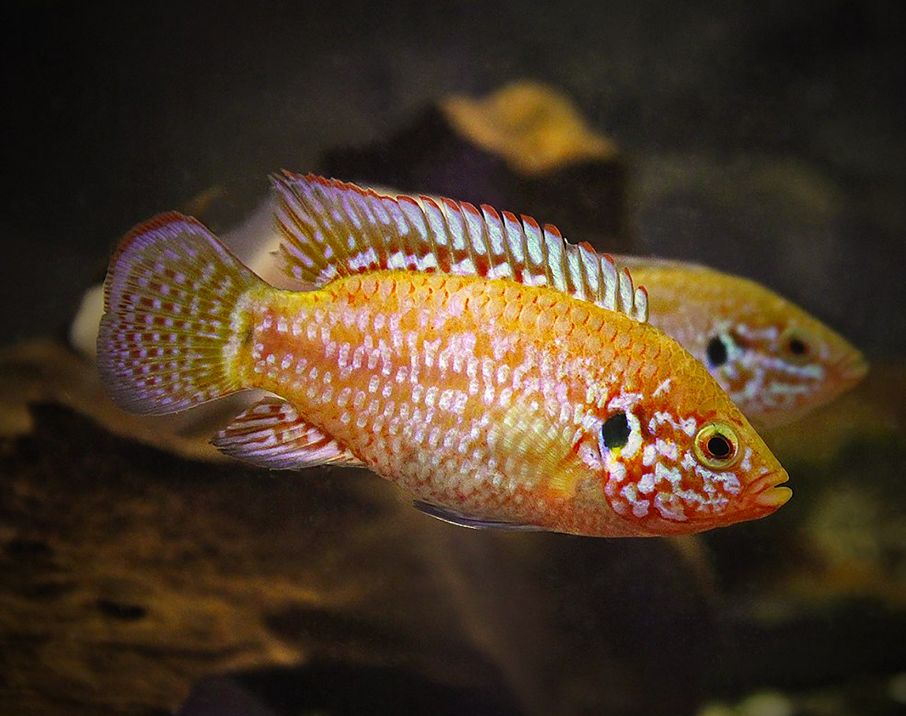
Contents
Habitat in the wild
The jewel cichlid, also known as the African jewel cichlid, belongs to the diverse family Cichlidae, which includes a wide range of freshwater fish found in regions like Africa, Central and South America, and parts of Asia. Cichlids are celebrated for their vibrant colors, intriguing behaviors, and complex breeding patterns, exhibiting a variety of temperaments from peaceful to highly territorial.
Native to West Africa, the jewel cichlid is commonly found from southern Guinea to central Liberia, primarily inhabiting rivers where it swims in the middle and bottom layers of the water column. These fish thrive in slow-moving or stagnant waters, such as lakes, rivers, streams, and flooded areas like swamps and marshes, often surrounded by dense vegetation and submerged structures like logs and roots.
In their natural habitat, jewel cichlids prefer warm waters with temperatures ranging from 24°C to 30°C (75°F to 86°F) and a pH level typically between 6.0 and 7.5, leaning towards slightly acidic to neutral conditions. They are often found in moderately hard water. It’s essential for aquarium keepers to replicate these conditions to ensure the health and well-being of jewel cichlids.
Hemichromis lifalili (jewel cichlid) vs Hemichromis bimaculatus (blood-red jewel cichlid)
Two closely related fish often referred to as “jewel cichlids” are Hemichromis lifalili and Hemichromis bimaculatus. While both species belong to the Hemichromis genus and share some similarities, they also exhibit distinct differences in appearance and behavior.
Hemichromis lifalili (Lifalili Cichlid or blood-red jewel cichlid) is native to the Democratic Republic of the Congo, particularly around the Lifalili River. These cichlids are relatively small, growing to about 3 to 4 inches (7.5 to 10 centimeters) in length. They display a vibrant red or orange-red base color adorned with iridescent blue scales on their upper bodies and fins, along with black markings and spots. Lifalili cichlids are generally more peaceful compared to other species in the genus but can exhibit territorial behaviors during breeding.
On the other hand, Hemichromis bimaculatus (Jewel Cichlid) is found in West Africa, including Nigeria, Guinea, Liberia, and Sierra Leone. Slightly larger than their Lifalili counterparts, jewel cichlids can grow to around 5 to 6 inches (12 to 15 centimeters). They are known for their striking coloration, featuring shades of red, blue, green, and black, with two distinct black spots—one at the base of the caudal fin and another on the operculum (gill cover). Jewel cichlids tend to be more aggressive and territorial, particularly during breeding and when defending their territories.
Both species are popular among aquarium enthusiasts for their stunning appearance. However, it’s essential to consider their behaviors and territorial tendencies when keeping them in a community aquarium. Providing adequate space, hiding spots, and compatible tank mates can help mitigate aggression and promote a more harmonious environment for both species.
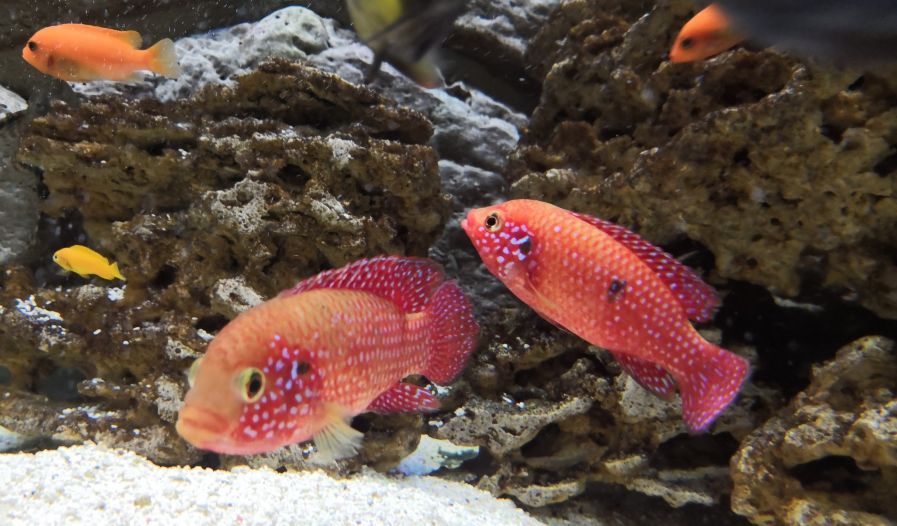
Description
Color
The name of this fish already hints at its striking beauty. Its body displays a vibrant red hue that can shift to a bright purple, especially when the fish is excited or during its spawning period. Scattered across its body are greenish spots, complemented by a distinctive black spot in the center. This vivid coloration not only enhances the fish’s appeal but can also indicate its health and well-being.
Size
The jewel cichlid typically reaches a maximum size of about 13 to 15 cm, making it relatively large for a cichlid. This measurement encompasses the fish’s full length, from the tip of its nose to the end of its tail fin. It’s important to note that individual jewel cichlids may vary in size; some might grow toward the upper end of this range, while others may remain slightly smaller.
Lifespan
Jewel cichlids typically have an average lifespan of around 5 to 8 years when kept in captivity under proper care. Understanding their lifespan is crucial for prospective owners, as several factors can influence their longevity. These include diet, water quality, tank conditions, genetics, and the overall care provided by the aquarium owner.
| Characteristic | Description |
|---|---|
| Scientific Name | Hemichromis bimaculatus |
| Common Names | Jewel Cichlid, African Jewel Cichlid |
| Family | Cichlidae |
| Origin | West Africa (Nigeria, Guinea, Liberia, Sierra Leone, etc.) |
| Size | Up to 5-6 inches (12-15 cm) in length |
| Lifespan | 5-8 years (can vary with proper care) |
| Coloration | Vibrant and iridescent with red, blue, green, and black hues |
| Temperament | Moderately aggressive and territorial |
| Diet | Omnivorous, eats both live and prepared foods |
| Preferred Water | Temperature: 24°C to 30°C (75°F to 86°F) |
| Parameters | pH: 6.0 to 7.5, moderate hardness |
| Aquarium Size | At least 30 gallons for a pair or small community |
| Tank Setup | Plenty of hiding spots, rocks, driftwood, and vegetation |
| Breeding | Mouthbrooders, females carry eggs and fry in their mouths |
| Compatibility | Can be aggressive towards other tankmates |
| Difficulty Level | Intermediate |
Difficulties in keeping
Caring for jewel cichlids is generally not difficult, but potential owners should be aware of their behavioral traits. Many amateurs are drawn to these fish for their bright colors and often keep them in community tanks with smaller fish. Unfortunately, jewel cichlids tend to be aggressive and may eventually prey on smaller tankmates. Therefore, this species is best suited for enthusiasts of African cichlids or those who understand the specific needs and behaviors of these fish. When housed with compatible species, jewel cichlids can thrive and display their vibrant colors without causing harm to others.
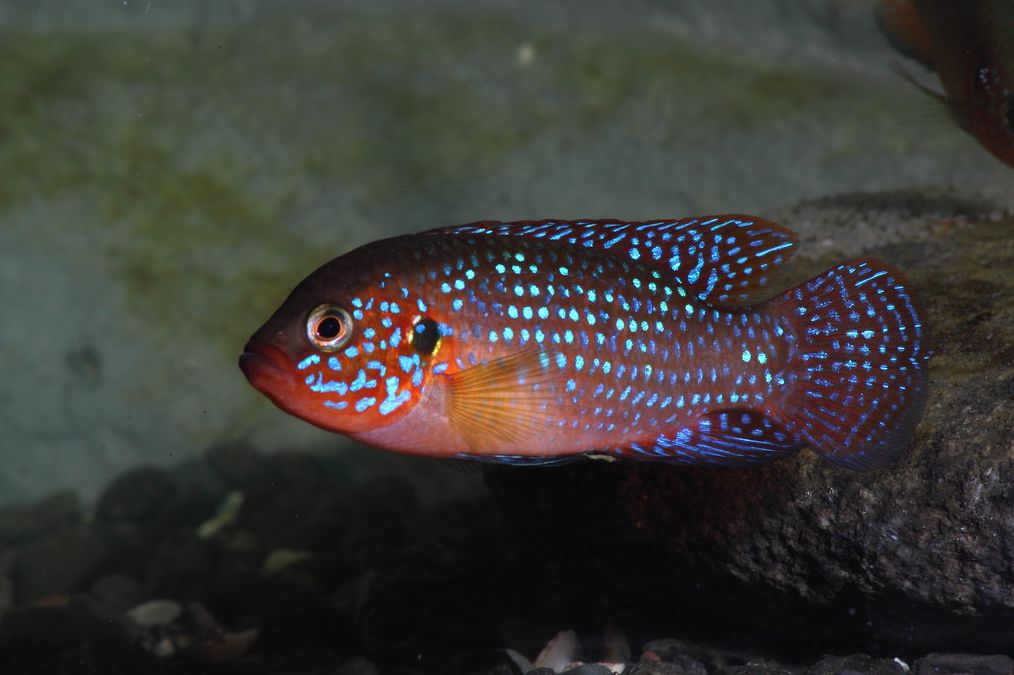
Care and keeping in a tank
Tank size
The minimum recommended tank size for a pair of jewel cichlids or a small community of these fish is around 30 gallons (113 liters). Since jewel cichlids are territorial and can be aggressive, providing this amount of space allows them to establish their territories and helps reduce potential aggression. It’s essential to include plenty of hiding spots, such as flowerpots, caves, tubes, and driftwood, as these features help create a more secure environment for the fish.
Jewel cichlids are especially territorial and aggressive during breeding and spawning, so having adequate space and suitable hiding areas can minimize conflicts. If you plan to keep a larger group or multiple pairs, consider a larger tank to accommodate their needs. A good guideline is to add an additional 10 gallons (38 liters) of tank space for each extra pair of jewel cichlids. This approach ensures that all fish have enough room to thrive and interact with less stress.
Tank decor
A sandy substrate is preferable for jewel cichlids, as they enjoy digging, which can cause the water to become muddied. Clean water is essential for jewel cichlids, just as it is for all African cichlids. Given their digging habits and dietary needs, using an external filter is advisable. Regular water changes and bottom siphoning are also necessary to maintain water quality.
Jewel cichlids are not well-suited for planted tanks, as they tend to uproot and damage delicate plants. It’s best to use sturdy, hardy plants like Anubias or larger plants in flowerpots that can withstand their digging behavior. These fish thrive in hard water, ideally not exceeding 12 dGH, but they can adapt to moderately hard conditions as well.
Water parameters
While they can adapt to various conditions, providing stable and suitable parameters is essential for optimal growth and behavior. Recommended water parameters include:
- Temperature: 24°C to 30°C (75°F to 86°F); they prefer slightly warmer water within this range.
- pH Level: 6.0 to 7.5; jewel cichlids can tolerate slightly acidic to neutral conditions.
- Hardness: Moderate to slightly hard, with a general hardness (GH) level between 5 to 15 dGH being appropriate.
- Ammonia, Nitrite, and Nitrate: Both ammonia and nitrite should be maintained at 0 ppm, as they are toxic to fish. Nitrate levels should ideally remain below 20 ppm.
A good filtration system is essential to maintain clean and healthy water, as jewel cichlids are sensitive to poor water quality. Regular water changes of at least 25% every 1 to 2 weeks can help keep parameters in check. A minimum tank size of 30 gallons is recommended for a pair of jewel cichlids, and if housing them with other tank mates, a larger tank with adequate hiding spots is crucial to minimize aggression.
Regularly testing water parameters using appropriate aquarium test kits will ensure they remain within these recommended ranges.
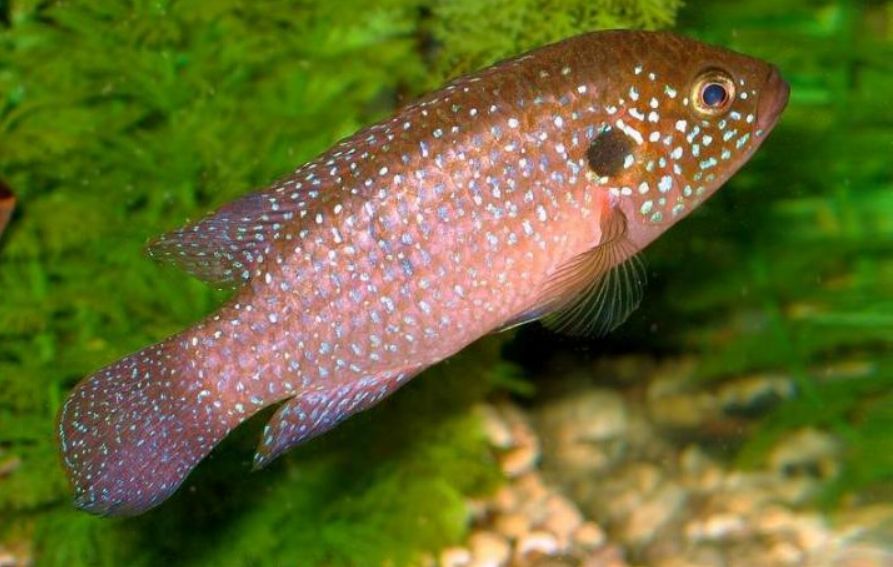
Diet
Jewel cichlids thrive on a varied diet, and while they readily eat all types of feed, offering live food can significantly enhance their coloration. Options such as bloodworms, tubifex, white worms, and fish frames are excellent choices. Additionally, incorporating plant-based foods like lettuce leaves or spirulina-based feeds provides essential fiber and nutrients.
For convenience, look for pellets or flakes specifically formulated for cichlids, as these contain vital nutrients and vitamins necessary for their growth and overall health. These commercial foods can serve as a staple in their diet, ensuring your jewel cichlids remain vibrant and healthy.
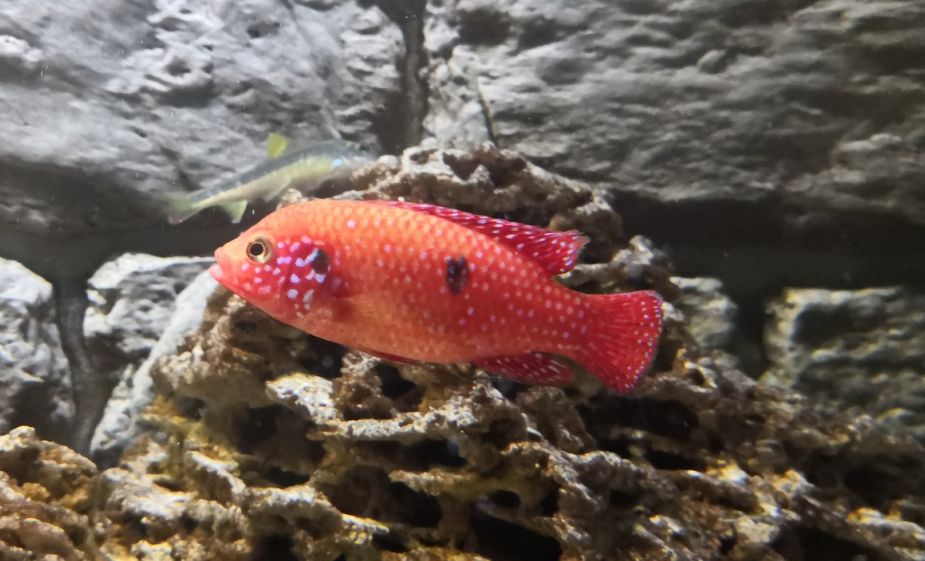
Tank mates
The jewel cichlid is known for its aggressiveness and territorial nature, especially during the spawning period. While they are best kept in pairs, it’s crucial for the partners to choose each other from a group of juveniles. Avoid keeping small fish, as jewel cichlids may see them as potential prey and could harm or eat them.
When selecting tank mates, consider the following options:
- Robust Cichlids: Other medium-sized cichlids can be good companions. Peaceful or semi-aggressive African cichlids, such as certain species from the African Rift Lakes, can coexist with jewel cichlids in larger tanks. Examples include african butterfly peacocks, lionhead cichlids, aulonocara, and kribensis.
- Bottom Dwellers: Bottom-dwelling fish that occupy different areas of the tank may also be suitable. Consider species like Corydoras catfish, Bristlenose plecos, or other non-aggressive catfish.
- Peaceful Schooling Fish: Schooling fish that inhabit the middle and upper regions of the tank can be compatible as well. Look for species like tetras, danios, or certain barbs, such as tiger barbs.
- Larger Characins: Some larger characin species, like buenos aires tetras or congo tetras, can tolerate the occasional aggression from jewel cichlids, making them potential tank mates.
Gender differences: male vs female
Generally, females are smaller and have a rounder abdomen, but there is no straightforward method for determining gender.
As jewel cichlids reach maturity, certain differences become more noticeable:
- Size: Males tend to be slightly larger with a more elongated and robust body compared to females.
- Coloration: Mature males usually display more vibrant and intense colors, especially during breeding or when asserting dominance. Their patterns often include more reds and blues.
- Fins: Male fins are typically more pointed and elongated, particularly the dorsal and anal fins, while females usually have more rounded fins.
- Black Spots: The characteristic black spot, or “eye spot,” on the side of the body is generally larger and more prominent in males than in females.
- Behavior: During the breeding season, males become more territorial and aggressive, displaying elaborate courtship behaviors to attract females for spawning.
While these differences can aid in identifying mature jewel cichlids, they are not always definitive. Individual variation can lead to subtle differences, making observation key for reliable identification.
Breeding
Jewel cichlids are monogamous, meaning once they choose a mate, they will breed only with that partner. However, identifying a compatible female can be challenging, as males and females are difficult to distinguish. If the chosen mate does not suit the male, aggressive behavior can lead to serious injury or even death.
When introducing a pair, it’s essential to observe their interactions closely. If they do not match well, one fish may suffer from damaged fins or other injuries. If the pairing is successful, the male’s colors will become more vibrant as he prepares to spawn. During this time, monitoring the female is crucial, as the male may become aggressive if she is not ready to breed.
The female lays up to 500 eggs on a pre-cleaned surface, often on smooth stones or inside flowerpots. After about two days, the eggs hatch into ich fry, which the parents care for by gathering and hiding them until they are ready to swim.
Approximately three days post-hatching, the fry will begin swimming independently. The male protects the juveniles by establishing a perimeter around them, while the female assists in their care.
Juveniles thrive on brine shrimp eggs, but growth patterns can vary, leading to cannibalism. It’s important to sort them to prevent this behavior. The parents will oversee the fry until they reach about 1 cm in length, after which they typically leave them to fend for themselves.